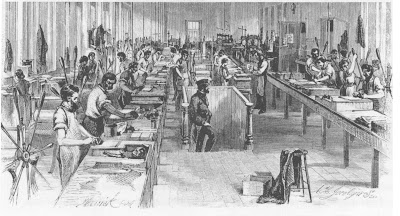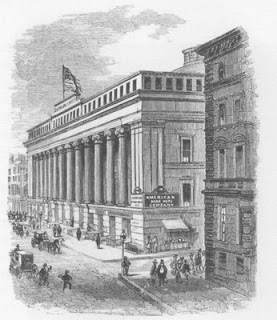Imported from: Google Blogger site
Original publish date: June 3, 2009
Updated: January 4, 2024
American Bank Note Company security printing
Here is a view of the printing department at American Bank Note Company in the late 1860s. There are probably 30 workers visible in addition to the guard at the top of the center stairway.

This factory scene took place in the penthouse of the Merchant’s Exchange Building at 48 Wall Street in Manhattan (55 Wall Street under the later street numbering system.) This location had been the previous headquarters of Rawdon, Wright, Hatch & Edson Co. You can see the penthouse in the view of the building’s exterior.
These images appear in The Story of the American Bank Note Company by William H. Griffiths (1958.) The engraver of the exterior view is unrecorded. The bottom right corner of the interior view is signed "A. H. Jocelyn", probably Albert Higley Jocelyn (1827-1900), an engraver covered briefly in Gene Hessler’s The Engraver’s Line. Albert Jocelyn’s uncle was Nathaniel Jocelyn, one of the founders of the American Bank Note Company in 1858.
It appears that ABNCo occupied its rented space at the Merchant’s Exchange Building between May 1860 and sometime in 1867.

During this period, the vast majority of ABNCo’s business was printing money for both the Federal government and private businesses. Its money printing endeavors increased throughout the late 1860s with increasing numbers of orders coming from other countries.
During the time ABNCo was located in the Merchant's Exchange, its printing of stocks and bonds was probably minimal. My database can identify only 52 extant varieties of railroad stocks and bonds (from 39 companies) that ABN had printed between 1858 and 1867.
Unfortunately for ABN, the Federal government took over all much of its own currency printing in 1874. By 1877, the government was printing all its own money. This move forced ABN to shift to printing stamps and money for foreign governments as well as stocks and bonds for both domestic and foreign businesses. This switch can be seen in the number of certificates printed by ABN after 1870.
No one knows how many certificate varieties ABN may have printed during the last decades of the 19th century, but it was huge. Counting only survivng railroad certificates, my database shows 246 new varieties printed during the 1870s, 1,250 during the 1880s, and 940 in the 1890s. Assuming that the surviving varieties of railroad certificates is only a third of the number ABN may have printed, the company probably contracted, designed, engraved, and printed an average of FIFTY new varieties railroad certificates every week from 1870 to 1899.
Throw in all the security printing it did for non-railroad businesses as well as all its foreign clients and we can see its security printing business was STAGGERING!